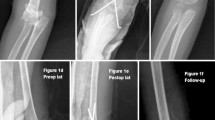Abstract
The objective was to evaluate the availability and efficacy of internal fixation with absorbable poly-D,L-lactic acid (PDLLA) pins for the treatment of late presenting irreducible Gartland type III supracondylar fracture of the humerus in children. Fifty-six cases of late presenting irreducible Gartland type III supracondylar fracture of the humerus in children were treated by open reduction and bioabsorbable PDLLA pin fixation from March 2005 to March 2008. The outcome of treatment was evaluated by the Mayo Elbow Performance Score (MEPS) and the criteria of Flynn. Fifty-six patients were followed up from 24 to 36 months (mean: 22 months). No displacement of bone fracture occurred, and all fractures healed within a normal time without wound infection; there were no cases of Volkmann’s ischaemic contracture, myositis ossificans or iatrogenic injury of the ulnar nerve. No residual vascular deficits or iatrogenic nerve injury were noted; cubitus varus deformity occurred in one case. There were 49 excellent, four good and three fair results according to the MEPS; the rate of excellent and good outcome was 94.6%. All children but one had excellent cosmetic results according to the criteria of Flynn. All of the children and their parents stated that they would choose this treatment again. Treatment of late presenting irreducible Gartland type III supracondylar fracture of the humerus in children with bioabsorbable PDLLA pins provides sufficient stability and satisfactory efficacy. The absorbable implant has become popular for its avoidance of a second operation to remove the internal fixation, and the degree of patient satisfaction is high.




Similar content being viewed by others
References
Hanlon CR, Estes WL Jr (1954) Fractures in childhood, a statistical analysis. Am J Surg 87:312–323
Reynolds RA, Jackson H (2005) Concept of treatment in supracondylar humeral fractures. Injury 36(Suppl 1):A51–A56
El-Adl WA, El-Said MA, Boghdady GW et al (2008) Results of treatment of displaced supracondylar humeral fractures in children by percutaneous lateral cross-wiring technique. Strategies Trauma Limb Reconstr 3:1–7
Lee YH, Lee SK, Kim BS et al (2008) Three lateral divergent or parallel pin fixations for the treatment of displaced supracondylar humerus fractures in children. J Pediatr Orthop 28:417–422
Omid R, Choi PD, Skaggs DL (2008) Supracondylar humeral fractures in children. J Bone Joint Surg Am 90:1121–1132
Otsuka NY, Kasser JR (1997) Supracondylar fractures of the humerus in children. J Am Acad Orthop Surg 5:19–26
Pirone AM, Graham HK, Krajbich JI (1988) Management of displaced extension-type supracondylar fractures of the humerus in children. J Bone Joint Surg Am 70:641–650
Kumar R, Malhotra R (2000) Medial approach for operative treatment of the widely displaced supracondylar fractures of the humerus in children. J Orthop Surg (Hong Kong) 8:13–18
Yen YM, Kocher MS (2008) Lateral entry compared with medial and lateral entry pin fixation for completely displaced supracondylar humeral fractures in children. Surgical technique. J Bone Joint Surg Am 90(Suppl 2 Pt 1):20–30
Morrey BF, An KN, Chao EYS (1993) Functional evaluation of the elbow. In: Morrey BF (ed) The elbow and its disorders, 2nd edn. Saunders, Philadelphia, pp 86–89
Flynn JC, Matthews JG, Benoit RL (1974) Blind pinning of displaced supracondylar fractures of the humerus in children. Sixteen years’ experience with long-term follow-up. J Bone Joint Surg Am 56:263–272
Kocher MS, Kasser JR, Waters PM et al (2007) Lateral entry compared with medial and lateral entry pin fixation for completely displaced supracondylar humeral fractures in children. A randomized clinical trial. J Bone Joint Surg Am 89:706–712
Williamson DM, Coates CJ, Miller RK et al (1992) Normal characteristics of the Baumann (humerocapitellar) angle: an aid in assessment of supracondylar fractures. J Pediatr Orthop 12:636–639
Loizou CL, Simillis C, Hutchinson JR (2009) A systematic review of early versus delayed treatment for type III supracondylar humeral fractures in children. Injury 40:245–248
Tiwari A, Kanojia RK, Kapoor SK (2007) Surgical management for late presentation of supracondylar humeral fracture in children. J Orthop Surg (Hong Kong) 15:177–182
Brauer CA, Lee BM, Bae DS et al (2007) A systematic review of medial and lateral entry pinning versus lateral entry pinning for supracondylar fractures of the humerus. J Pediatr Orthop 27:181–186
Waris E, Ashammakhi N, Kelly CP et al (2005) Transphyseal bioabsorbable screws cause temporary growth retardation in rabbit femur. J Pediatr Orthop 25:342–345
Rokkanen PU, Böstman O, Hirvensalo E et al (2000) Bioabsorbable fixation in orthopaedic surgery and traumatology. Biomaterials 21:2607–2613
Author information
Authors and Affiliations
Corresponding author
Rights and permissions
About this article
Cite this article
Fu, D., Xiao, B., Yang, S. et al. Open reduction and bioabsorbable pin fixation for late presenting irreducible supracondylar humeral fracture in children. International Orthopaedics (SICOT) 35, 725–730 (2011). https://doi.org/10.1007/s00264-010-1018-4
Received:
Revised:
Accepted:
Published:
Issue Date:
DOI: https://doi.org/10.1007/s00264-010-1018-4




